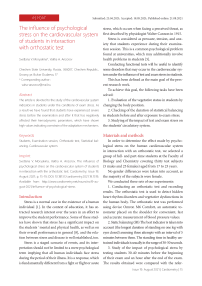The influence of psychological stress on the cardiovascular system of students in interaction with orthostatic test
Автор: Svetlana V. Moryakina, Vakha A. Anzorov
Журнал: Cardiometry @cardiometry
Статья в выпуске: 19, 2021 года.
Бесплатный доступ
The article is devoted to the study of the cardiovascular system indicators in students under the conditions of exam stress. As a result we have found that students have experienced severe stress before the examination and after it that has negatively affected their hemodynamic parameters, which have shown high values indicating overstrain of the adaptation mechanisms
Students, Examination session, Orthostatic test, Statistical balancing, Cardiovascular system.
Короткий адрес: https://sciup.org/148320546
IDR: 148320546 | DOI: 10.18137/cardiometry.2021.19.1519
Текст научной статьи The influence of psychological stress on the cardiovascular system of students in interaction with orthostatic test
Svetlana V. Moryakina, Vakha A. Anzorov. The influence of psychological stress on the cardiovascular system of students in interaction with the orthostatic test. Cardiometry; Issue 19; August 2021; p. 15-19; DOI: 10.18137/cardiometry.2021.19.1519; Available from:
Stress is a normal case in the existence of a human individual [1]. In the context of education, it has attracted research interest over the years in an effort to improve the student performance. Some of these studies have shown that stress has a significant impact on the students ‘ mental and physical health, as well as on their overall performance in general [8], and the relation between stress and disease is well established, too.
Stress is a staged scenario of events, and its interpretation should not be limited to a mere psychological term implying that all human individuals face stress during the period of their illness. It is a response, which is fundamentally different from a fight or flight or acute stress, which occurs when facing a perceived threat, as first described by physiologist Walter Cannon in 1915.
Stress is considered as pressure, tension, and anxiety that students experience during their examination session. This is a common psychological problem found at universities, which may additionally involve health problems in students [5].
Conducting functional tests will be useful to identify some disorders that may occur in the cardiovascular system under the influence of test and exam stress in students.
This has been defined as the main goal of the present research work.
To achieve this goal, the following tasks have been solved:
-
1. Evaluation of the vegetative status in students by changing the body position.
-
2. Checking of the duration of statistical balancing in students before and after exposure to exam stress.
-
3. Studying of the impact of test and exam stress on the students’ circulatory system.
Materials and methods
In order to determine the effect made by psychological stress on the human cardiovascular system in interaction with an orthostatic test, we selected a group of full- and part-time students at the Faculty of Biology and Chemistry covering thirty test subjects (5 males and 25 females) aged from 17 to 23 years.
No gender differences were taken into account, as the majority of the subjects were female.
We conducted three sets of our experiments:
-
1. Conducting an orthostatic test and recording results. The orthostatic test is used to detect hidden heart rhythm disorders and vegetative dysfunctions in the human body. The orthostatic test was performed using device Omron M6 Comfort, an automatic tonometer placed on the shoulder for convenient, fast and accurate measurement of blood pressure values.
-
2. Static balancing (SB) The best indicator is taken into account (the longest duration of standing on one leg with eyes closed) assessing three attempts with an interval of 5 minutes between them. The standing time in healthy untrained individuals is usually in the range of 30-50 seconds.
-
3. Study of the impact of psychological stress by testing students 30-40 minutes before the beginning of their exam and an hour after the end of the exam. The results obtained were compared with the refer
Issue 19. August 2021 | Cardiometry | 15
ence values of those hemodynamic parameters, which were recorded in the same cohort of the students two weeks before the examination session.
The dynamics of heart rate (HR) values, the data on systolic blood pressure (SBP) and diastolic blood pressure (DBP) were analyzed.
After recording the produced data, we calculated the following: the mean dynamic pressure (MDP), the systolic blood volume (SBV), the total peripheral vascular resistance (TPVR), the Kerdö index (KI) and the adaptive potential (AP) [4].
Results and discussion
After statistical processing using the Excel 2016 program, the experimental data obtained can be presented as follows.
To assess the state of the autonomic nervous system, the functional orthostatic test is of particular interest. The use of the orthostatic test (transition from the horizontal to vertical position) allowed us to establish a decrease in the systolic blood volume by an average of 16%, an increase in the heart rate value by an average of 14 beats / min (17%) and in the total peripheral vascular resistance (TPVR) by an average of 28%. The diastolic blood pressure parameter increased by an average of 13 mm Hg (18%), the systolic pressure was 8 mm Hg (6%) higher, and the average dynamic pressure parameter reached 11.8 mm Hg (13%). Based on the normal values of the indicators, it has been found that the level of tolerance to the orthostatic test corresponds to the satisfactory assessment of the functional ability of the students’ circulatory system (see Figure 1 herein).
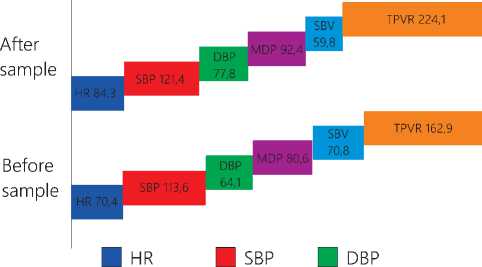
I MDP □ SBV □ TPVR
Figure 1. Change in the parameters of the cardiovascular system in students when performing orthostatic test
In our studies, the rise in the pulse rate after the orthostatic test amounts to 17% that is similar to the average degree of excitability of the sympathetic sub- 16 | Cardiometry | Issue 19. August 2021
division of the autonomic nervous system that demonstrates the activation of the adaptive processes [3].
Then we have analyzed the duration of static balancing, which may deliver a lot of information about the actual health of the student (see Figure 2 herein).
Static balancing (SB)
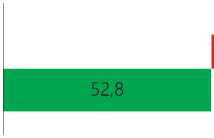
31,28
I 2 weeks before session ■ 30 minutes before exam
Figure 2. Comparison of changes in the duration of static balancing in students under the influence of psychological stress
Upon conducting the above test, we arrived at a conclusion that all students demonstrated standard indicators of the duration of balancing (from 30 to 50 seconds).
But at the same time it was found that the best indicators thereof were recorded two weeks before the exam session, i.e. at the level of 52.8 seconds that was even slightly higher than the physiological norm for untrained individuals.
This shows that there is the proper motor coordination, the well-developed state of musculoskeletal system and the psychical stability. All this is applicable rather to the students two weeks before the start of the exam session, since at that time they have a better developed perception based on the motor stimuli.
The students demonstrated their worst result (31.28 seconds) 30 minutes before the start of the exam, which was close to the lower limit of the average normal value.
The impact of psychological stress on the circulatory system of students showed that the heart rate two weeks before the start of the session averaged 71.7±1.94 beats/min. The reference indicators were compared with the data received 30 minutes before the start of the exam, and an increase in the heart rate values by 20% was revealed. An hour after passing the exam, the pulse rate of most students did not reach the reference values and on average decreased by 2% only. The available research literature suggests that there is a rise in heart rate, when exposed to stress, by 8-19 beats per minute [2] that was also confirmed in our previous studies [7].
As to the recorded blood pressure values, there was an increase in the spread of the indicators in the group compared to the norm.
Psychological stress also changed other hemodynamic parameters in the students. Thus, before the exam, the total peripheral vascular resistance (TPVR) significantly increased from 199.0±4.52 kPa2s/l to 281.2±28.64 kPa2s/l, (P <0.05), and after the exam, there was a decrease in TPVR to 226.6±10.65 kPa2s/l (Р <0,02). At the same time, the average values of systolic blood volume (SBV) were recorded to be 11% lower before the exam and 3% lower after the exam [12] (see Table 1 herein).
Table 1
Dynamics of changes in the cardiovascular system parameters in students under the influence of psychological stress
|
Studied parameter |
М±m |
||
|
Reference |
Before exam |
After exam |
|
|
HR, bpm |
71.7±1.94 |
89.4±2.78** |
87.2±2.39** |
|
SBP, mm Hg |
115.6±2.02 |
126.6±2.55** |
121.2±2.03 |
|
DBP, mm Hg |
73.4±0.88 |
84.5±2.80** |
78.3±1.70* |
|
SBV, ml |
61.8±1.35 |
55.2±2.45* |
59.2±2.11 |
|
TPVR, кPа2s/l |
199.0±4.52 |
281.2±28.64* |
226.6±10.65 |
|
KI, % |
1.6±2.08 |
14.9±2.09** |
9.1±1.89* |
|
AP, points |
2.1±0.04 |
2.6±0.08** |
2.4±0.05** |
*Р <0.01; **Р <0.001
Thus, the cardiac activity of students is greatly influenced by the sympathetic nervous system that is confirmed by the relevant data available in the relevant research paper sources [6].
To determine the predominant subdivision of the autonomic nervous system responsible for the activity of the cardiac system, we calculated the Kerdö index [9].
In the students, the Kerdö index (KI) before the exam significantly increased from 1.6±2.08 % to 14.9±2.09 %, and after the exam, its progressive decrease was noted at the level of 9.1±1.89 %.
Stress leads to a higher tension of the functions of the human body, especially of the cardiovascular system, in order to properly provide the organs and the tissues with nutrients and oxygen supply. As a result, the adaptation capabilities of the body’s systems may be disabled and a number of diseases caused by stressful factors may develop [11]. For this purpose, we calculated the adaptive potential (AP). Before the start of the exam, we noted the AP increase of 19 units, and after the end of the exam we recorded its rise by 13 units. The results obtained are statistically reliable (see Figure 3 herein).
This response made by the hemodynamic parameters to the exam stress conditions bears witness to the
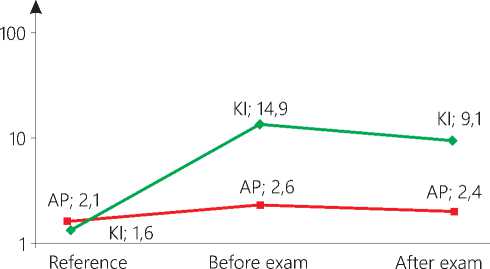
-^ АР —♦— KI
Figure 3. Change in the indicators of KI and AP in students under the influence of psychological stress fact that the nervous mechanisms of the regulation of the circulatory system are involved in the process that leads to an increase in the activity of the cerebral cortex. As a result, under the influence of the cerebral cortex, the activation of the cardiovascular system has occurred before the exam [13].
Different human individuals have different abilities to adapt to stressful influences. The origin of a number of diseases is based on the phenomenon of adaptation failure [10]. The level of health depends on the individual capabilities of the adaptive systems in the student’s body.
We also considered the individual characteristics of the body’s response to exam stress. Analyzing thirty subjects studied, we identified two female students and one male student who had a tendency to produce a hyperreaction to psychological stress (test subjects No. 2, 7, and 27).
The reason for this sort of behavior is, in our opinion, that these students are not confident in themselves before the exam (it is possible that the material is not fully mastered), constantly doubt about their abilities and expect the worst outcome from the events.
Under psychological stress, in the selected group of the subjects, the systolic blood pressure increased in No. 2 by 38%, in No. 7 by 12% and in No. 27 by 26%, while the diastolic blood pressure increased by 40%, 29%, and 46%, respectively. The total peripheral resistance was recorded to be 67%, 46%, and 77% higher, respectively.
At the same time, there was a significant decrease in the systolic volume by 60%, 32% and 47%, respectively (see Figure 4, 5, 6 herein).
The exams can be considered as a sort of sought-after experience that initiates tension because it’s “a big gamble”.
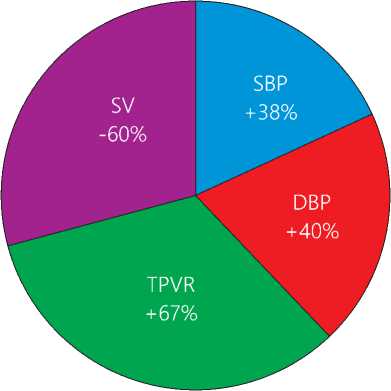
Figure 4. Percent ratio of indicators of the cardiovascular system in student No. 2 before the exams under the influence of psychological stress
The tension before the exam is usually associated with the fear that students will disappoint their parents with their improper performance and that they cannot meet their own expectations. This group of students has a risk of developing hypertension due to stress [14].
Conclusions
-
1. In our studies, a change in the body position (orthostatic test) led to an increase in the pulse rate by 17% that is similar to the average degree of excitability of the sympathetic subdivision of the autonomic nervous system. Based on the normal values of the indicators, it was found that the level of tolerance to the orthostatic test was satisfactory considering the assessment of the functional ability of the students’ circulatory system.
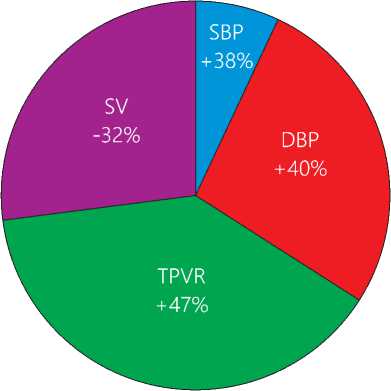
Figure 5. Percent ratio of indicators of the cardiovascular system in student No. 7 before the exams under the influence of psychological stress
-
2. According to the duration of static balancing, the best results were shown by those students who conducted this test two weeks before the start of the exam session. The results obtained were taken as the reference values. These rates were 59.2% higher than the data obtained 30 minutes before the beginning of the exam.
-
3. The response made by the cardiovascular system indicators (SBP, DBP, TPVR, SBV) in the students to exam (psychological) stress is generally adequate to the reaction pattern described in the available reference literature.
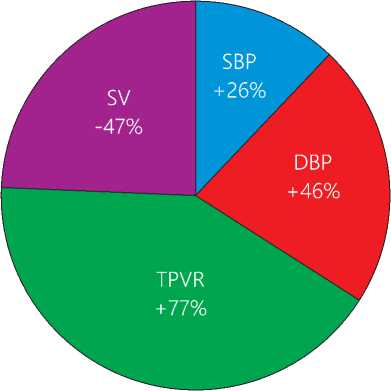
Figure 6. Percent ratio of indicators of the cardiovascular system in student No. 27 before the exams under the influence of psychological stress
-
4. Upon our survey of thirty students, a “risk group” was identified, consisting of two female students and one male student, who demonstrated a tendency to hyperreact to psychological (exam) stress. The reason for the behavior is, in our opinion, that these students were not confident in themselves before the exam (it was possible that the material was not fully mastered), constantly doubted about their abilities and expected the worst outcome from the events.
Statement on ethical issues
Research involving people and/or animals is in full compliance with current national and international ethical standards.
Conflict of interest
None declared.
Author contributions
The authors read the ICMJE criteria for authorship and approved the final manuscript.
Список литературы The influence of psychological stress on the cardiovascular system of students in interaction with orthostatic test
- Agadzhanyan NA, Baevsky RM, Berseneva AP. Assessment of the adaptive capabilities of the body and the risk of developing diseases. Moscow: RUDN Publishing House, 2006. 284 p.
- Alekseeva EA, Shantanova LN, Petunova AN. Assessment of the functional state of the body of students during the examination stress. Bulletin of the Buryat State University. 2010;12:108-13.
- Aref ’eva AV, Fateeva NM, Glukhikh TA, Turysheva AA. Adaptation of students to educational stress. Journal of scientific articles Health and Education in the XXI century. 2012;14(1):89.
- Kalyuzhny EA, Maslova VYu, Titova M, Maslova M. Implementation of the index method for assessing the physical development of students. Modern scientific research and innovation. 2014;6-3(38):19.
- Kiyaeva EV, Alidzhanova IE, Akimov SS. Evaluation of the functional state and adaptive potential of students of various social groups. Modern problems of science and education. 2014; 6:984.
- Kolomiets OI, Petrushkina NP, Makunina OA. Morbidity and vegetative status of first-year students as indicators of the strategy of adaptation to learning in higher educational institutions. 2015; 1(119):97-103.
- Moryakina SV, Anzorov VA, Khatueva YaR. Influence of physical and psychoemotional (examination) stress on the hemodynamic indicators of students. Modern research in the field of natural, technical and physical-mathematical sciences: collection of results of scientific research. Kirov: Publishing House of ANO DPO “Interregional Center of Innovative Technologies in Education”, 2018. pp. 374-381.
- Nadezhkina EYu, et al. Influence of exam stress on the functional state of the cardiovascular system and the level of anxiety in students with different types of higher nervous activity. Vestnik VolgSMU. 2017; 2(62):115-118.
- Roslyakova EM, Alipbekova AS, Igibaeva AS. Indicators of the functional state of the cardiovascular system of students in the conditions of adaptation to higher education depending on the vegetative status. International Journal of Applied and Fundamental Research. 2017; 5-2:252-6.
- Fateeva NM. Adaptation of students to exam stress. Symbol of Science. 2016;1:32-4.
- Dragos D, Tanasescu MD. The effect of stress on the defense systems. Journal of Medicine and Life. 2010;3(1):10-8.
- Koide R, Harada T, Aoi S, et al. Study of objective evaluation of response to a psycho-logical stressor using peripheral circulation monitoring devices. Medical Consultation New Remedies. 2012;1333-8.
- McEwen BS. Physiology and neurobiology of stress and adaptation: central role of the brain. Physiological Reviews. 2007; 87:873-904.
- Shaikh RB, et al. Knowledge regarding risk factors of hypertension among entry year students of a medical university. Journal of Family & Community Medicine. 2011; 18 (3):124-9.

